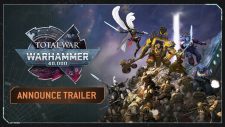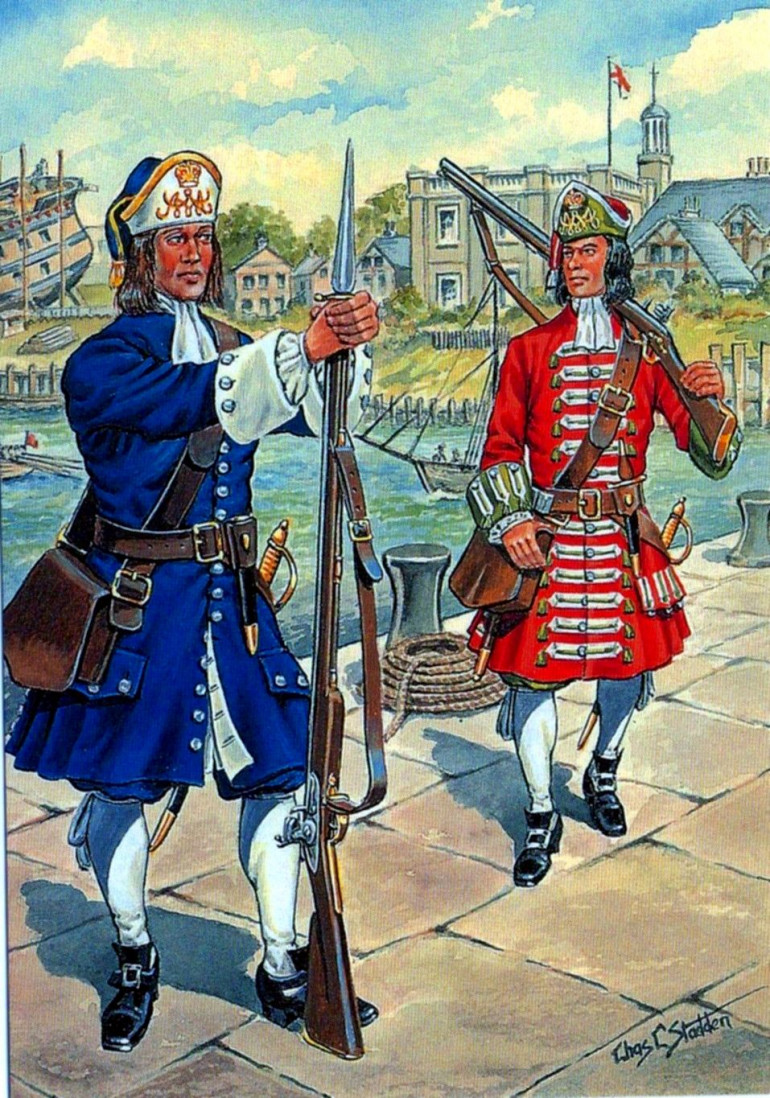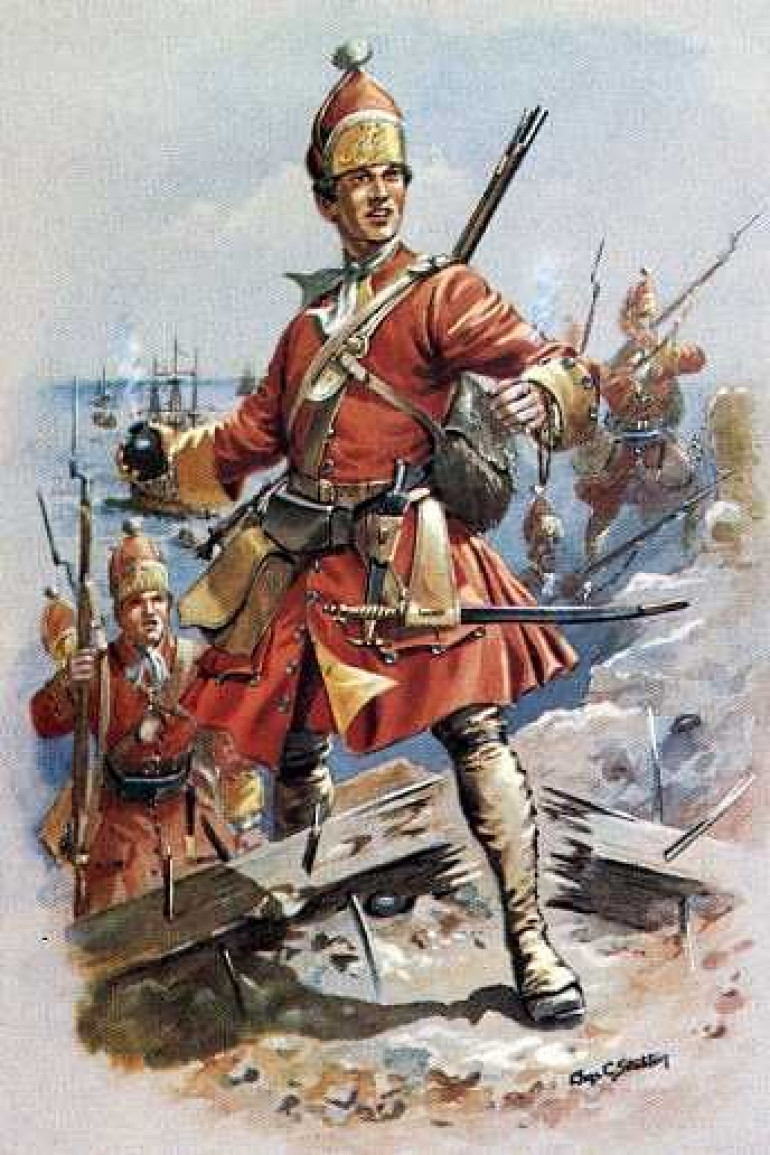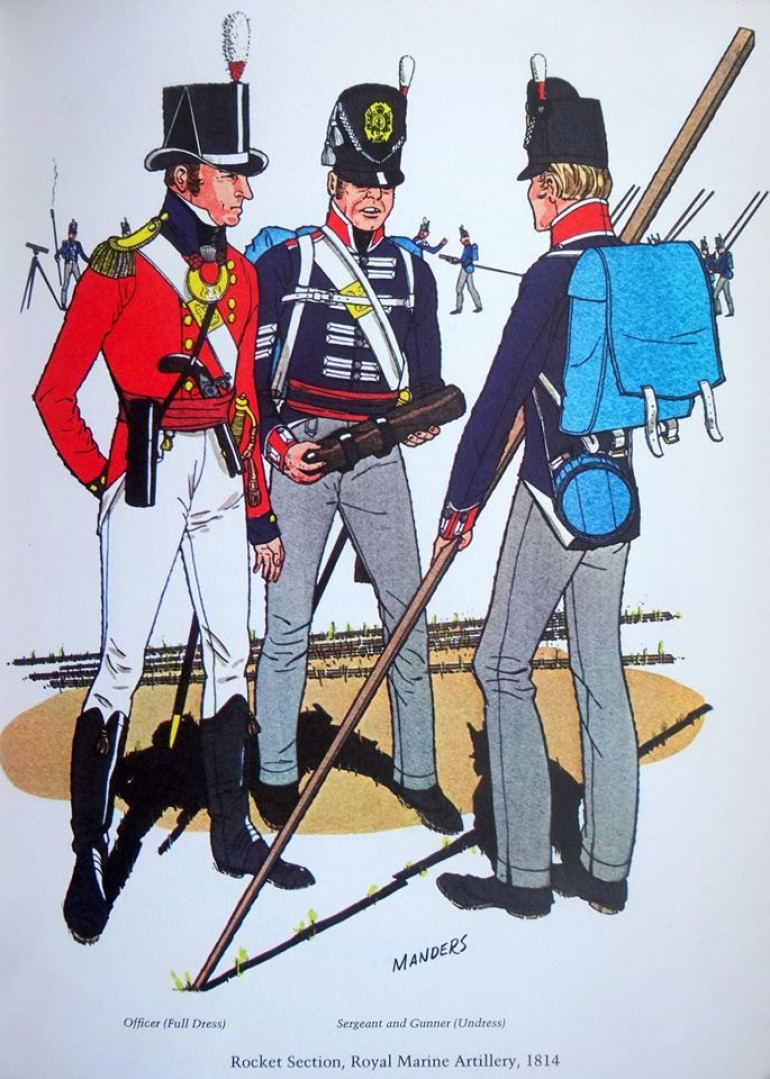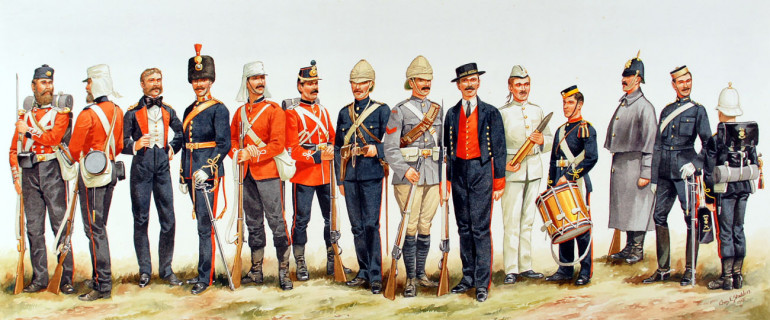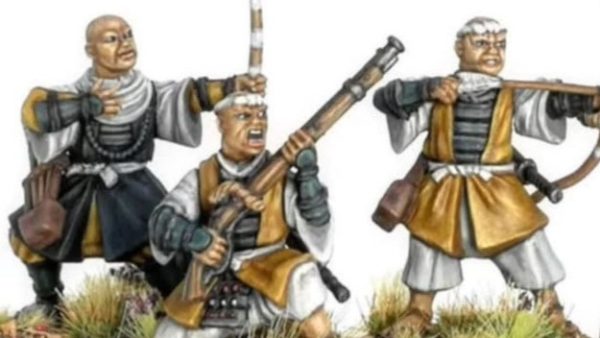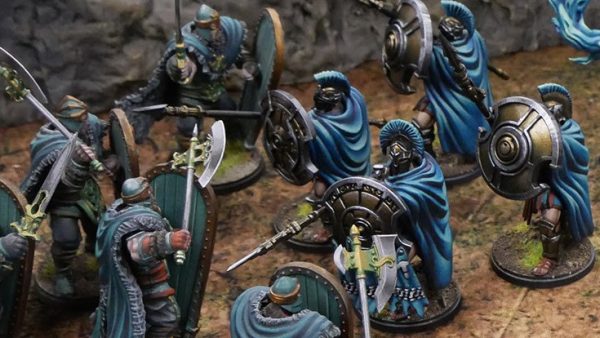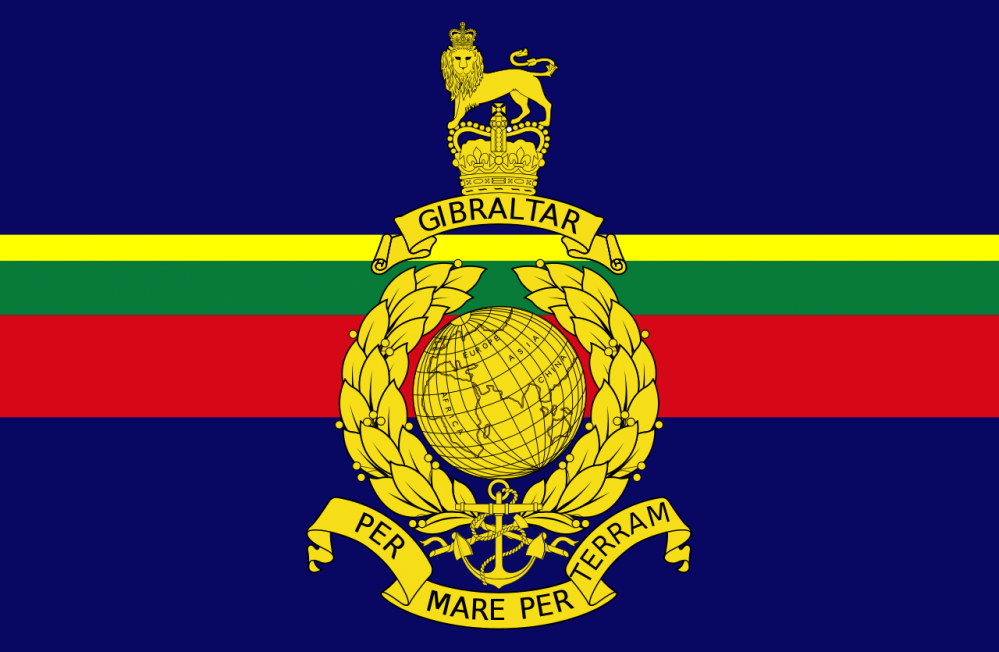
Per Mare Per Terram
Recommendations: 38
About the Project
A reference guide for the Royal Marines though time. Focusing on uniform variations and equipment through their long history and miniature suggestions for those considering building a Marine detachment for various games at various moments in time. (This project is best read from 'oldest first)
Related Genre: Historical
This Project is Completed
What's all this, then?
For many years I have had an interest in military uniforms at various times in history, particularly British history, and over the years I’ve acquired a fair number of sources and information on a wide array of things that are very useful when building historically accurate minis for war games. Obviously, the minute details such as the engravings on buttons are not relevant for most scales of wargaming, but the general look and colours are so I thought I’d start creating some reference guides for others using my knowledge.
I decided to start with the Royal Marines due to family connections to the organisation which includes, notably, my great grandfather, G. H. Gill, GM. While I still haven’t managed to get a copy of his medal citation, I do know that he was awarded the George Medal for saving people from an ammunition laden ship that was ablaze at the time. Sadly, I never knew him myself but I was very pleased to learn that his medals were given to the Royal Marine Museum which, at the time, were based in Eastney near Portsmouth. Importantly, I am going to make sure that I cover all of the branches of the Marines when and where they crop up, so I will not be focusing purely on the line that leads to the famous Royal Marine Commando units that are often best known.
The Admiral's Regiment
In 1664, the long history of what would become the Royal Marines began with the formation of the Duke of York and Albany’s Maritime Regiment of Foot. Alongside the Holland Regiment (that later became a line infantry regiment), they were paid for by the Navy and used as sea-borne infantry which basically consisted of fighting on the ships during naval battles, but also assisting in landings, and the like. This is also a during a time where Regiments of Foot were sometimes ‘borrowed’ by the Navy to augment their Marines in times of need, such as the Battle of Solebay during the 3rd Anglo-Dutch War. If you look into it yourself, the term used for such units is that they are employed as Marines, or something similar. For now, though, let’s focus on the Admiral’s Regiment (the name the Duke of York and Albany’s Maritime Regiment of Foot became known as…you can understand why…
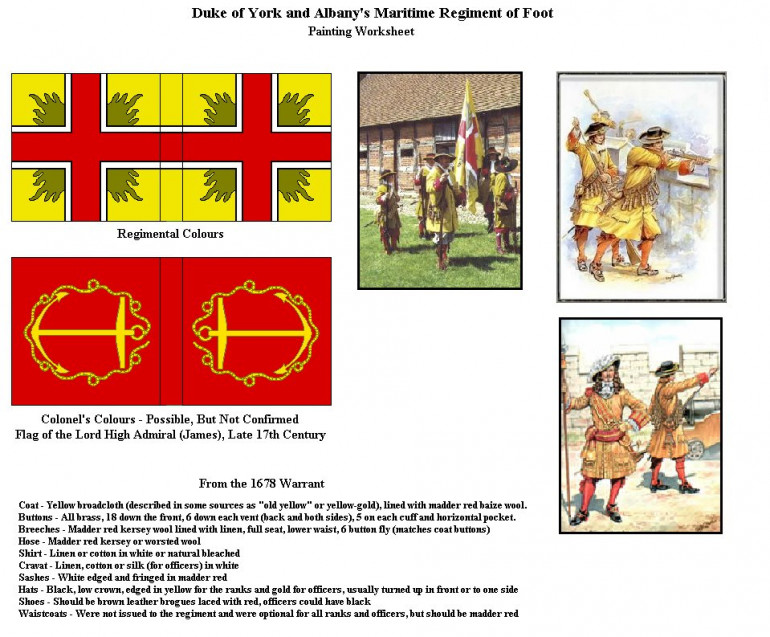 This image is probably the most useful for us gamers out there, and covers pretty much everything we need.
This image is probably the most useful for us gamers out there, and covers pretty much everything we need.The colours only go so far when trying to find miniatures, however, so when looking out for a mini you can use you really want to think about the uniforms the British Army were wearing at the time, and the equipment they were carrying. An important note on weapons is that standards of the time were very different. A colonel of a regiment was responsible for outfitting his men so a certain degree of variation across an army would have been common. This was a practice up to as late as 1745, but for the Admiral’s Regiment the most likely weapons would have been matchlock guns with the possibility of some flintlocks creeping in as time went by.
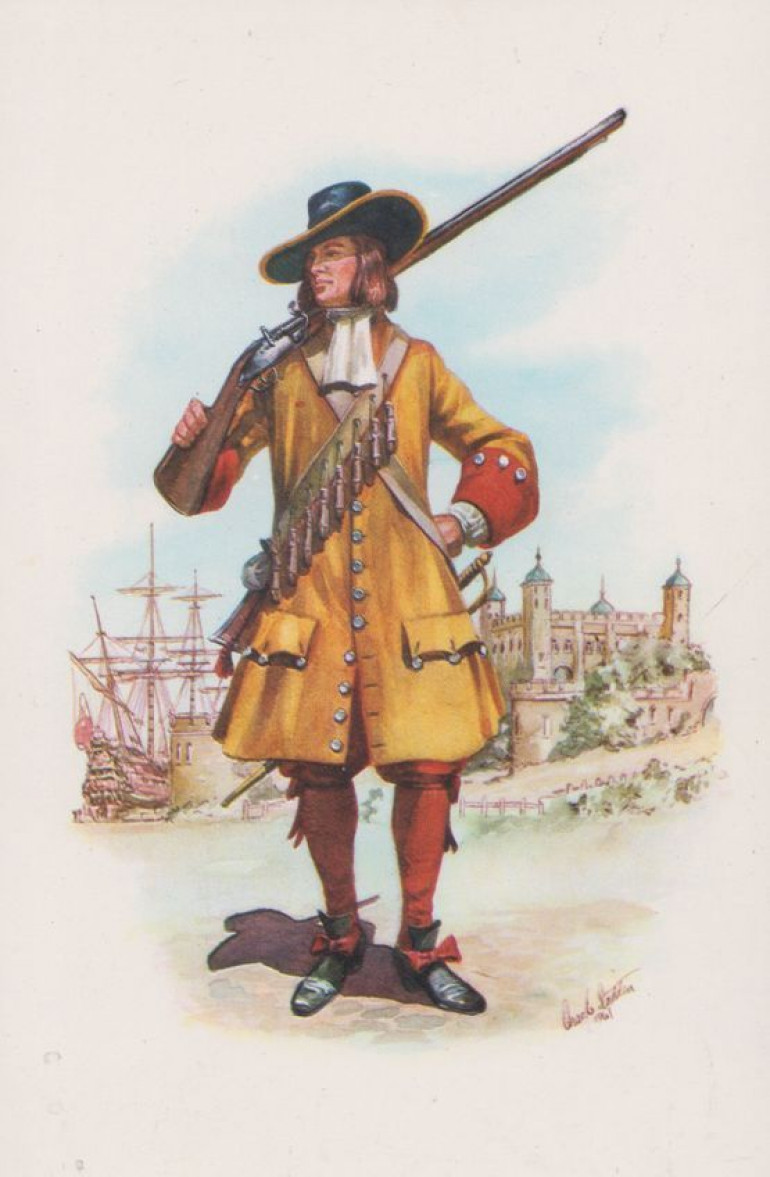 Here you can see a matchlock over the shoulder. For those unsure what I mean you can see the 'lock plate' on the side of the musket above the trigger. Where the plate goes towards the Marine's neck you can just make out a lit piece of potassium nitrate soaked cord called a match. This would be lit and swung into the priming pan of the musket to fire the charge.
Here you can see a matchlock over the shoulder. For those unsure what I mean you can see the 'lock plate' on the side of the musket above the trigger. Where the plate goes towards the Marine's neck you can just make out a lit piece of potassium nitrate soaked cord called a match. This would be lit and swung into the priming pan of the musket to fire the charge.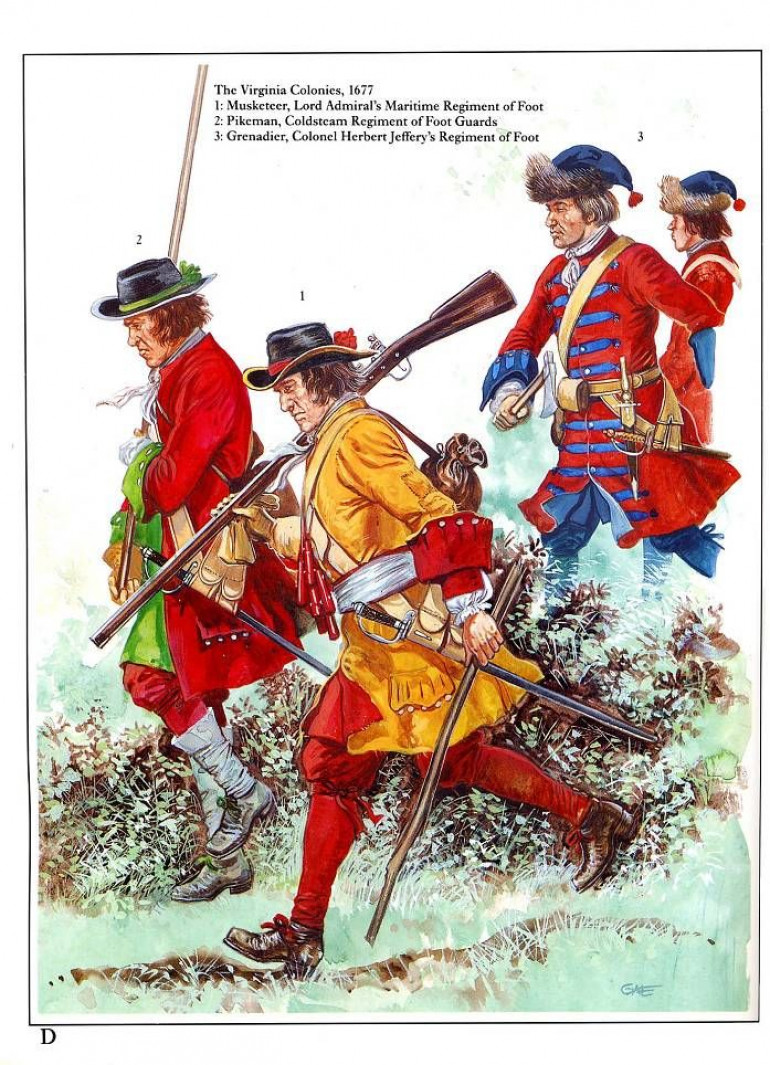 By contrast, the Marine pictured here has a noticible hammer pointing up from above where the trigger is. This mechanism forces a piece of flint to scrape along a piece of steel called a frizzen to create sparks to ignite the priming powder. The obvious advantage here is that would don't have a constantly burning thing attached to the explody thing. Science is great.
By contrast, the Marine pictured here has a noticible hammer pointing up from above where the trigger is. This mechanism forces a piece of flint to scrape along a piece of steel called a frizzen to create sparks to ignite the priming powder. The obvious advantage here is that would don't have a constantly burning thing attached to the explody thing. Science is great.The next question is minis. This regiment existed from 1664 until James II was deposed in 1689 and places them in the ‘Pike and Shotte’ era of wargaming, albeit the tail end of this period. While I don’t doubt that there is a company out there who make purpose built minis to represent these chaps, my ‘readily available’ would be the New Model Army era minis as they will be readily available. Warlord, for example, makes a set of them in, I believe, metal, but there may be a company somewhere that makes plastics. With modification you could use some of the Marlborough’s Wars Grand Alliance Infantry from Warlord, but you would need to find the right headgear and, in general, it would be too much of a faff to do it without it becoming more trouble than the metal minis.
The Williamite War in Ireland
This is a very short bit on the Earl of Pembroke’s and Earl of Torrington’s Marine regiments that existed for a short time and took part in the landings at Cork in 1690. I know very little about them, but including this one piece of artwork I have found may be useful to someone covering ‘That One Time the Bastard English Wouldn’t Leave Ireland Alone Part 56’.
Capturing Gibraltar.
When you are really proud of a Battle Honour, you put it on your Regimental Colours, when you are exceptionally proud of it, you put it on your badges. For the Marines, this is Gibraltar, an Honour they wear to this day, so it makes sense to cover it here.
The most important change by this point is that the Marine regiments were wearing the red of the British Army. In fact, almost all of the uniform patterns between the Army and the Marines were identical due to the nature of raising and re-designating regiments over time. For example, Villier’s Regiment were raised as Marines, then later re-designated as Line Infantry and becoming the 31st Foot. In this way, Marine Regiments were not permanent and raised to requirement.
 Here I am unsure if this headgear denotes grenadiers or is simply the headware of the Marines, but as the officer is wearing the tri-corn hat, my assumption is that these hats denote genadier rather than Marine and the rank and file Marines also wore tri-corns in the Army's style.
Here I am unsure if this headgear denotes grenadiers or is simply the headware of the Marines, but as the officer is wearing the tri-corn hat, my assumption is that these hats denote genadier rather than Marine and the rank and file Marines also wore tri-corns in the Army's style.While I only found very poor quality pictures of such, as these regiments were much more of the Army style, the facing colours are of importance and, as with the Army regiments, were a way of telling each unit apart. The yellow in these images would be indicative of Villier’s regiment rather than just meaning ‘Marine’. Other regimental distinctiveness would be far too small to show up in gaming scales, so I won’t worry about it. It should be said, though, that the taping of the second image, opposed to the lack of such in the first, is quite possibly artistic license and I would suspect that the lack of taping around button holes would be the more accurate.
As for model suggestions, it goes without saying that the War of the Spanish Succession era British, or Grand Alliance, infantry are the way to go. Warlord does a plastic box set, though I am sure others do as well. The only complication would be headgear. I am am correct in my assumption of tri-corns, then the box would be fine as is, but the grenadier mitres used in the box would not be correct to those in the artwork I have presented here. So I would suggest sticking to tr-corns of the era unless you could find a source of those particular mitres from another company.
His Magesty's Marine Forces
In 1755, the first permanent Marine force was created with stations at Portsmouth, Chatham, and Plymouth. This force very closely mimicked the army in appearance, including all the changes as time when on. This included headgear for grenadier battalions and also some of the, sometimes short-lived, changes of light infantry battalions, as the introduction of those forces carried on. The early permanent Marines were very much an extension of regular infantry units serving on ships and used for landings and such, but also more extensive land combat. It should be noted, though, that the primary purpose of these men was the defense of land stations and as security and discipline aboard ships, and to fight from the decks while in naval combat.
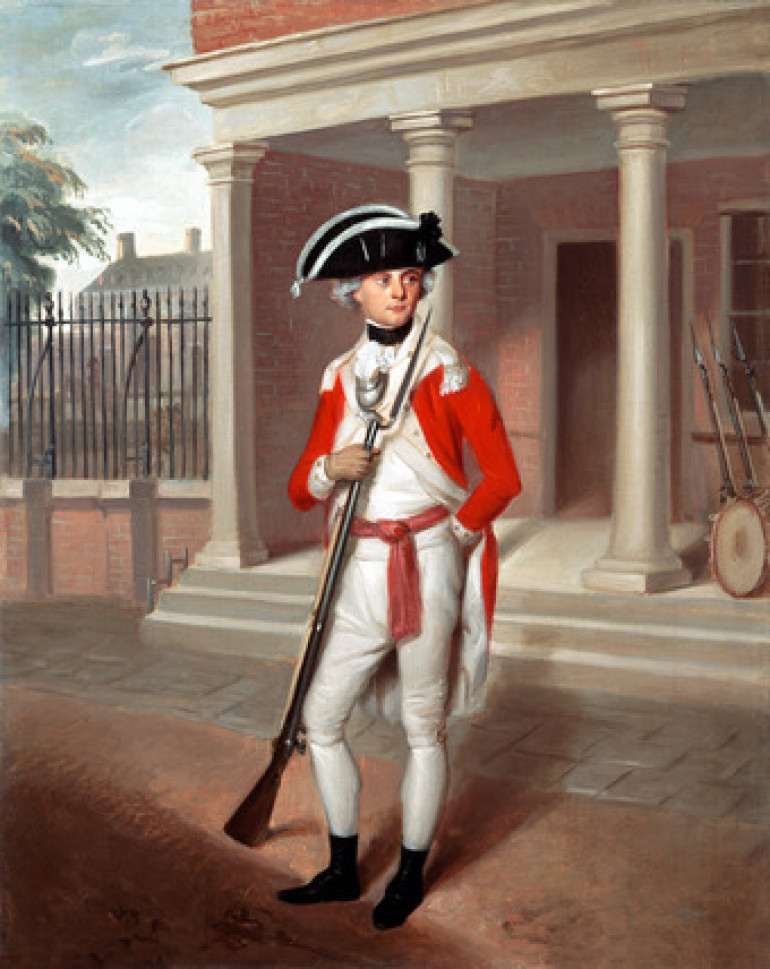 Pictured here is an officer who, at first glance, looks like a regular army officer with the same cut of uniform and such like. Of note here, though, are the facings (cuffs and collars, mostly) which are white.
Pictured here is an officer who, at first glance, looks like a regular army officer with the same cut of uniform and such like. Of note here, though, are the facings (cuffs and collars, mostly) which are white.Whereas before, each regiment of Marines could have whatever colour their Colonels chose, all Marines of this new force were assigned the colour white. This is because they were, less and less organised into the same regiments as the army. In fact the initial force was 50 companies within 3 divisions (one each for Portsmouth, Chatham, and Plymouth). This actually makes marines of this time very easy to replicate in miniature form as you can very simply pick up a box of regular army units of the time and simply paint the facings white.
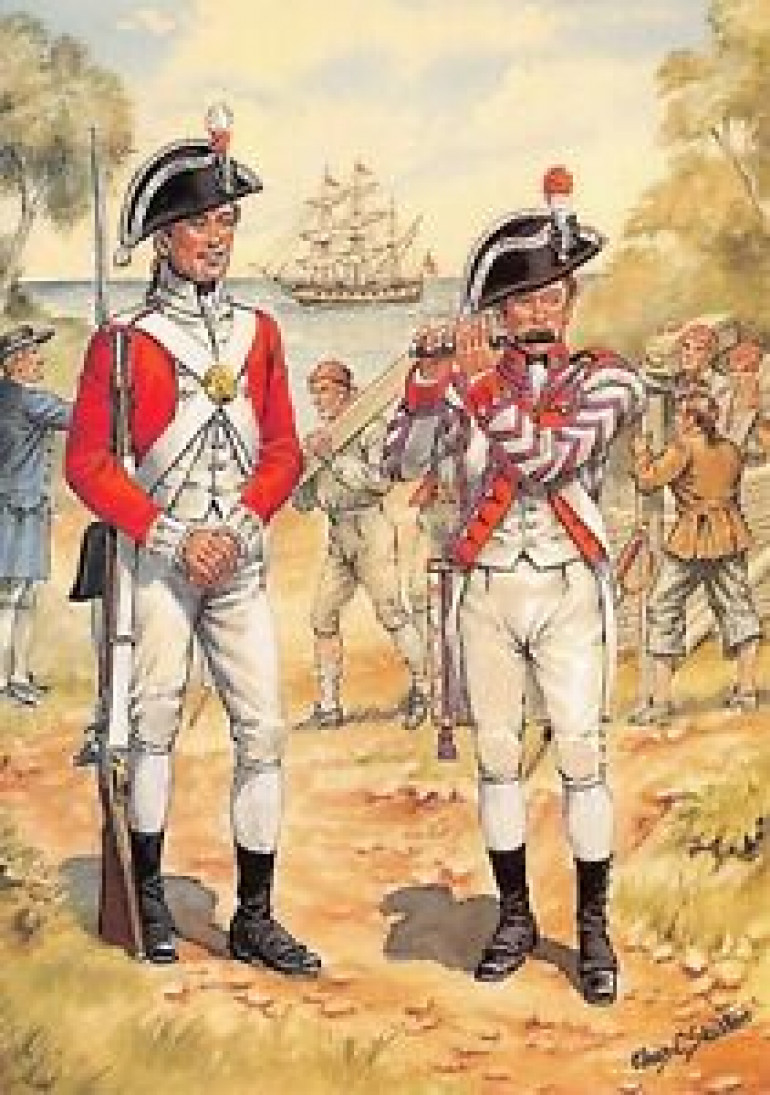 This is a bit blurry, but does show that the drumers and fifers of the Marines were even wearing the 'reverse colours' that regular army units of the time did, as well. If anyone has seen Master and Commander (and if you haven't, do) you may have noticed that it is a Marine who 'Beats to Quarters' when a ship goes into action...though we'll get to the Napoleonic Marines later.
This is a bit blurry, but does show that the drumers and fifers of the Marines were even wearing the 'reverse colours' that regular army units of the time did, as well. If anyone has seen Master and Commander (and if you haven't, do) you may have noticed that it is a Marine who 'Beats to Quarters' when a ship goes into action...though we'll get to the Napoleonic Marines later.This period includes The Seven Years War and The American Revolution, which are mostly likely to be the more popular areas of wargaming here, but luckily you could very easy supplement the same basic British Infantry in as Marines, just remember the white facings and, if you really wanted to go an extra mile, maybe paint one of the officers of a regiment (in massed combat systems) as a Naval officer as it wasn’t until 1771 that any Marine officer was promoted to the rank of Colonel because the Naval officers felt that their ranks were honorary anyway. I know that Warlord and Perry Miniatures have some plastic infantry of these types, though you may also find that Victrix do as well. I would say that this is still a time where Marines are better suited to Skirmish games, but it was Major Pitcairn’s Marines that took the redoubt at Bunker Hill, so there are moments of larger engagements.
The French Revolution and Boney's Wars
During the French Revolutionary Wars and Napoleonic Wars, you have Nelson’s great battles such as The Nile, Copenhagen, and Trafalgar and in all these battles and many of the landings that occurred throughout you would find Marines. Copenhagen is also the 95th (Rifles) premiere where they acted as Marines to add their accuracy to the rapidity of regular musket fire, but that’s for another day. There are three notable changes during this time; facings, headgear, and a new type of Marine.
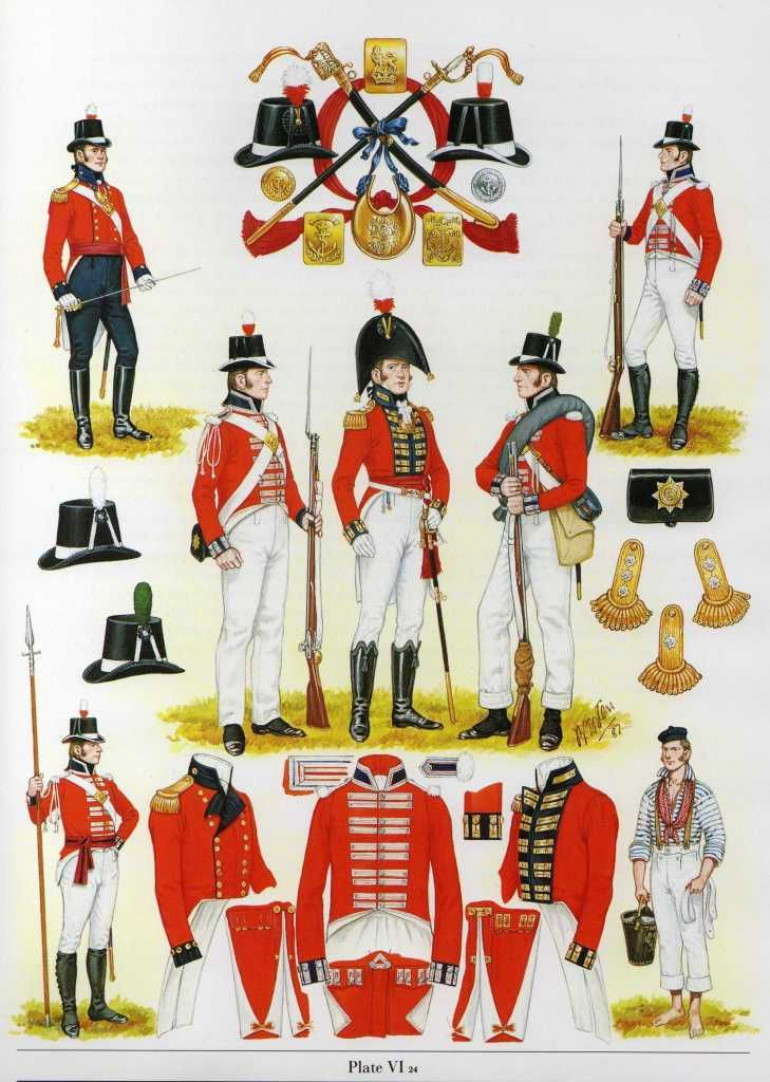 In 1802, His Magesty's Marine Forces were formally named The Royal Marines. The 'royal' epithet attached to any regiment grants them the right to have royal blue facings, and so the white was gone and in came the blue.
In 1802, His Magesty's Marine Forces were formally named The Royal Marines. The 'royal' epithet attached to any regiment grants them the right to have royal blue facings, and so the white was gone and in came the blue.Having blue facings was very much an honour in the army, due to the connection to royalty. In fact there are many extant regiments of the British Army that have royal connections in their names with many of them being carried over from antecedents. The second thing you will notice there is the hat. While I’m not entirely sure when this particular hat came into use, it is very distinct to the Royal Marines of this time and I can find evidence to suggest that it was not in use in, definitely, the early years of the French Revolution. I would summise that when the army changed to shakoes, the Royal Marines switched to these dapper top hats quite possibly for practicality of maintenance at sea, but I don’t know for sure. The hats do have a hackle on them (the fluffy bit sticking out the side) and those were in the traditional Battlaion colours of white over red.
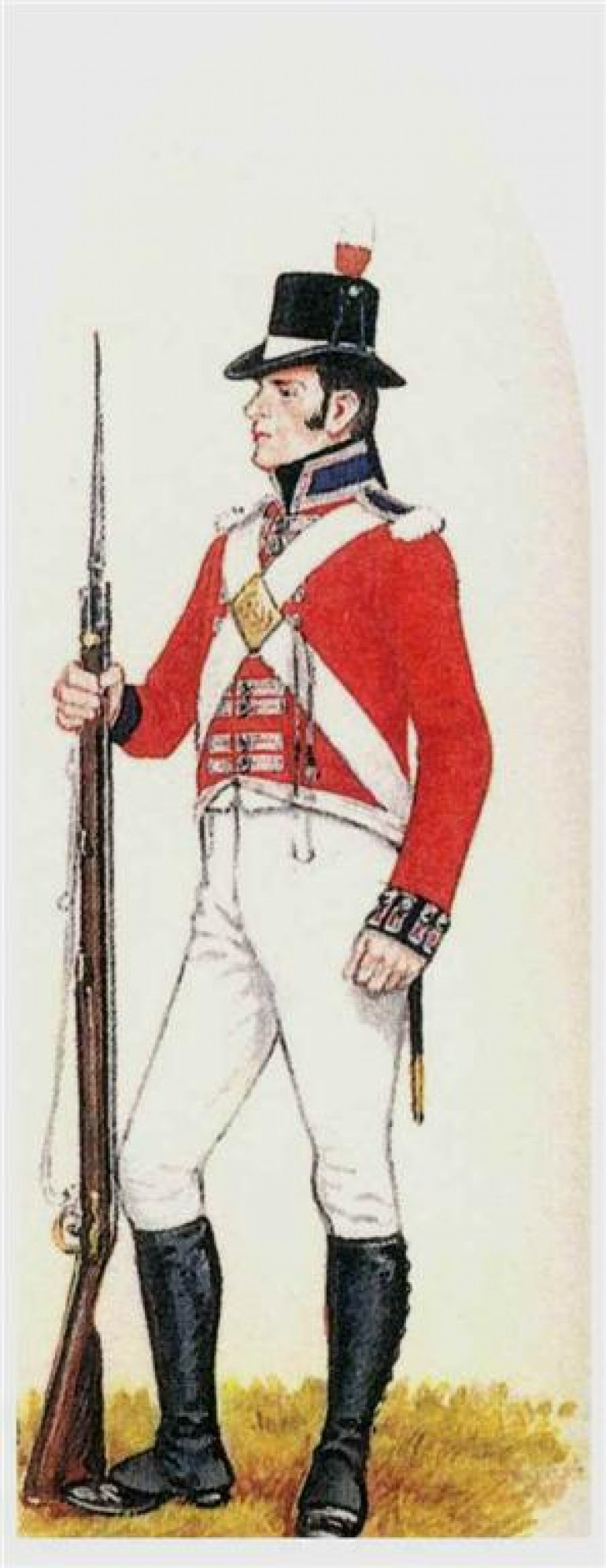 The Marines also had their own pattern of musket at this time, but for all intents and purposes of model scales, they are identical, so we don't have to worry about that.
The Marines also had their own pattern of musket at this time, but for all intents and purposes of model scales, they are identical, so we don't have to worry about that.In 1804 the Royal Marine Artillery was formed, mainly to operate the heavy weapons on bomb ships, but were also trained in other types of gunnery. While the were initially supposed to wear the same uniform as the regular Marines, they quickly made attempts to switch to the traditional blue uniforms of the regular Royal Artillery and the Admiralty eventually relented when it became clear they were doing it anyway. As far as I am aware, they wore the same headgear as the ‘red’ Marines, however there is a lot of artwork surrounding their use on land during the War of 1812 to suggest that the ‘Belique’ pattern of shako was worn, but I’d say that for a model perspective it could easily be a headswap, or just leave them in the shakoes; quite useful, actually.
I think it is an important distinction, though, to say that the hackle may have remained the same white over red, which would serve to distinguish from the regular Royal Artillery, who had pure white hackles. Saying the word ‘hackles’ is fun, you should try it.
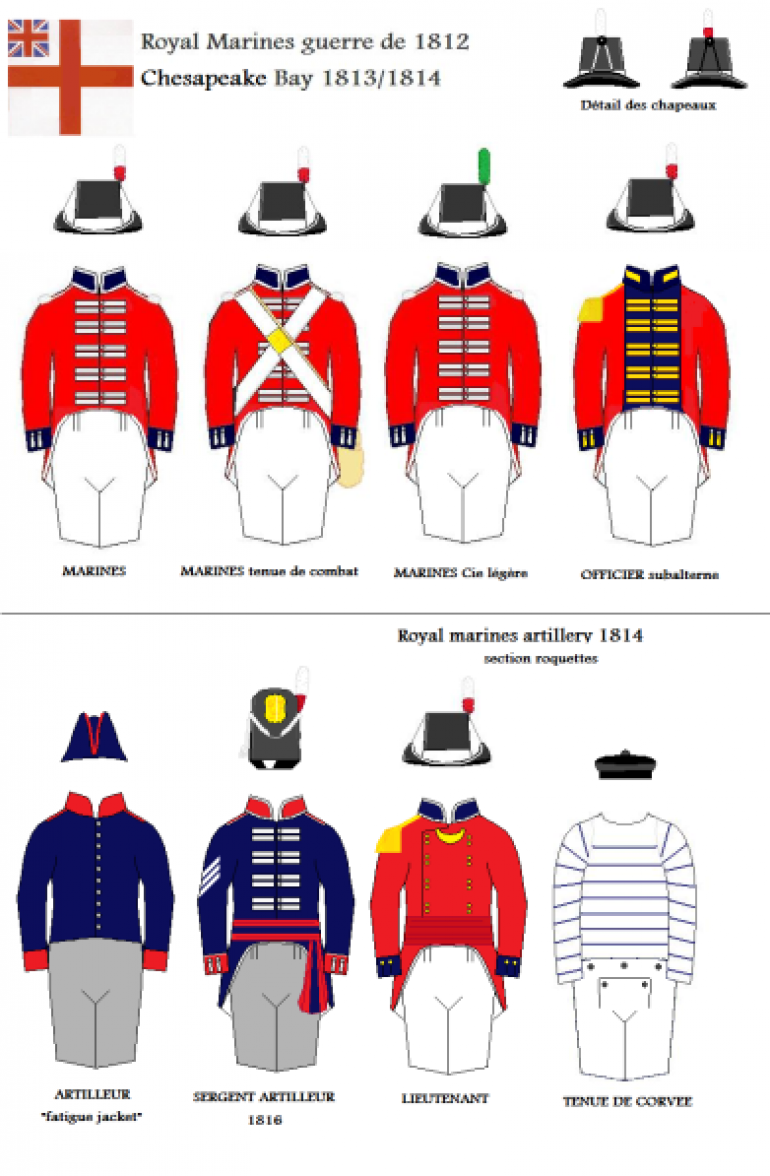 A nice general overview of the uniforms of the Napoleonic Wars. I wish the chap who drew these had an easy place you could find them all...even if they are all in French...
A nice general overview of the uniforms of the Napoleonic Wars. I wish the chap who drew these had an easy place you could find them all...even if they are all in French...Again, these chaps are best suited to smaller games, but there are times where they were used in force, quite often with large sections of the Ship’s Company. Particularly in the War of 1812, where most soldiers were tied up in the Peninsular War and other conflicts, Marines were often borrowed for other duties.
As for miniatures, these chaps pose the largest problem due to the hats, however there is a ‘conversion kit’ out there that works with almost any plastic Napoleonic Infantry. The sculpts have been know to move around companies, but for the moment you can find them here. I really ought to get my set at some point…
http://brigadegames.3dcartstores.com/BG-NBR313-Napoleonic-British-Marine-Heads-and-NBR040-British-Marine-Command-Figures_p_3319.html
With those little extras, though, you can easily build your own Marines, just remember that you won’t need the Ensigns (flags) from a regular regiment or the wings of the flank companies. You can save these to make a Light Infantry regiment and the spare Ensigns could be used to change around some other regiments you have painted (switch between the yellow faced 6th and 100th foot, for example). This does mean that Marines will cost a little extra, but due to the nature of marines, you would probably only need a single unit so it’s not so bad.
The Crimean War and Victoria's Empire
After a brief exploration into haberdashery, the Royal Marines returned to the regular army headgear following the Napoleonic period. In the run up to the Crimean War the Royal Marines and Royal Marine Artillery continued to emulate their regular army compatriots with no colour changes as time went by. They also began to adopt a few more embellishments, alongside the army, to their hat such as brass plates, but in general the details on these are too small to worry about for wargaming. This real difference here is remembering that the Royal Marines have no colours (in the sense of flags) which is an easy way of battlefield identification during this time.
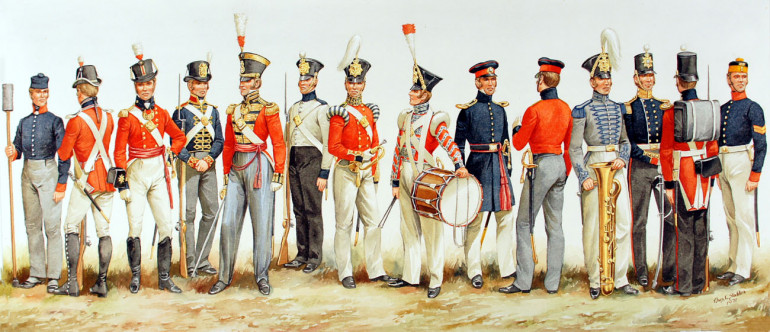 This is a nice simple timeline of the Royal Marines running from the Napoleonic period to the Crimean War.
This is a nice simple timeline of the Royal Marines running from the Napoleonic period to the Crimean War.During the Crimean War, two things happened. One, the army realised that tight fitting waist high jackets with long tails were a bad idea for soldiers (that took them way too long…), and in 1855 the infantry component of the Royal Marines were named to, first, the Royal Marines Light Infantry and then Royal Marine Light Infantry (RMLI). The navy then began organising Naval Divisions for landings over time and used the RMLI as an initial force meant to take a beach and secure a perimeter while the Navy landed more sailors trained in infantry roles. This would continue throughout the 1800’s with the Royal Marines following the uniform patterns of their army contemporaries. As the 1800’s rolled on, the changes in army uniform were adopted by the Royal Marines as well, with some exceptions for specific campaigns as time went on. While the red and blue were maintained for ceremonial purposes, it seems silly to include those elements for wargaming…
And so, once again, for miniatures, the Marines can be very easily played using regular army miniatures from any of the ranges. Once again, though, remember that they carried no colours and operated very much as skirmishers towards the latter half of the century, but many companies have plastic kits for the Crimean War, the Zulu War, and many others of the period.
The Great War and the Interwar Years
Entering the 20th Century you’ll find the Royal Marines more difficult to identify as all armies moved towards drab and camouflaged uniforms to better protect their men from the new ‘modern’ warfare. An important not, however, is that along with ceremonial dress uniforms, the early part of the 1900’s has a type of uniform refereed to as Home Service uniform that we will not cover too much simply because it is not a ‘battle’ uniform that is important for wargamers.
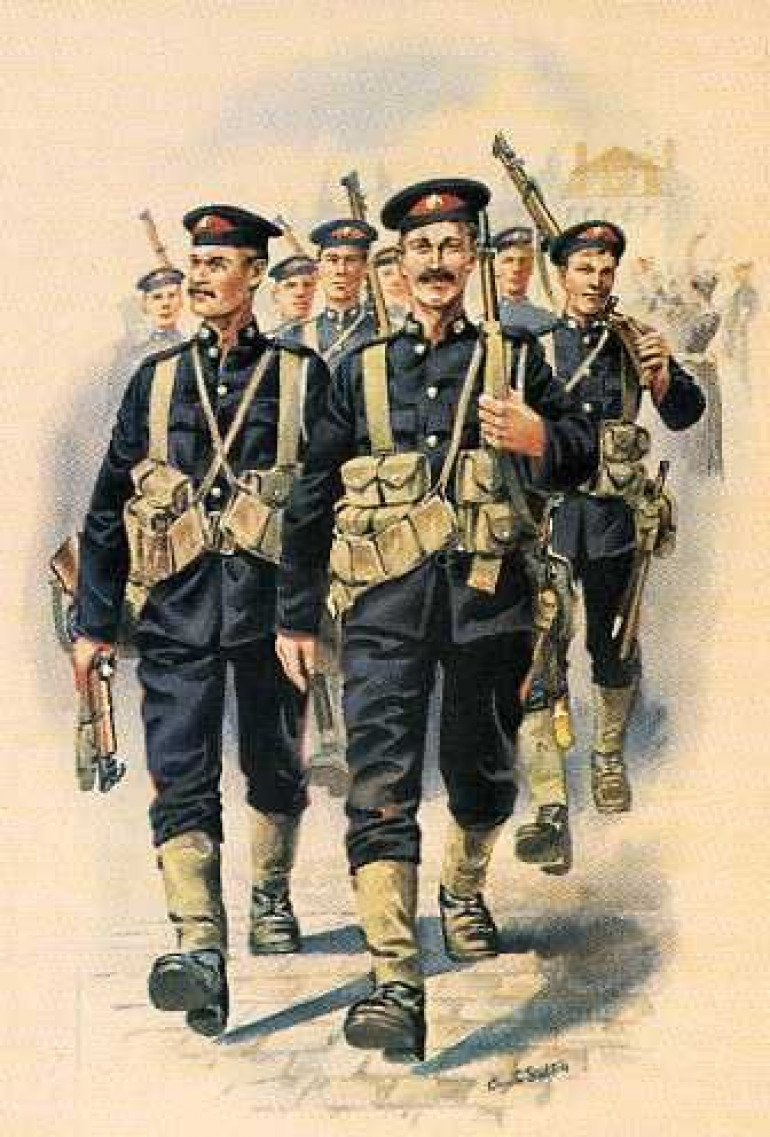 In the early years of the war, the Royal Marines appear to have worn the blue uniforms of their naval service and formed the much more 'professional' brigade of the Naval Division that was later in the war passed to Army control and dubbed the 63rd (Royal Naval) Division.
In the early years of the war, the Royal Marines appear to have worn the blue uniforms of their naval service and formed the much more 'professional' brigade of the Naval Division that was later in the war passed to Army control and dubbed the 63rd (Royal Naval) Division.Throughout the war the RMLI fought as light infantry and the Royal Marine Artillery manned the big guns for the division and would switch from the more conspicuous blues to the less visible khakis of the regular army. As will become commonplace in combat after the Great War, the Marines will be commonly recognised by Corps symbols on their uniforms that are typically not viable at smaller scales and simple decals at larger ones. If you wish to do the Naval Division, as a whole, for this conflict then the non Marines part of the division do have a fair number of differences that you could look up.
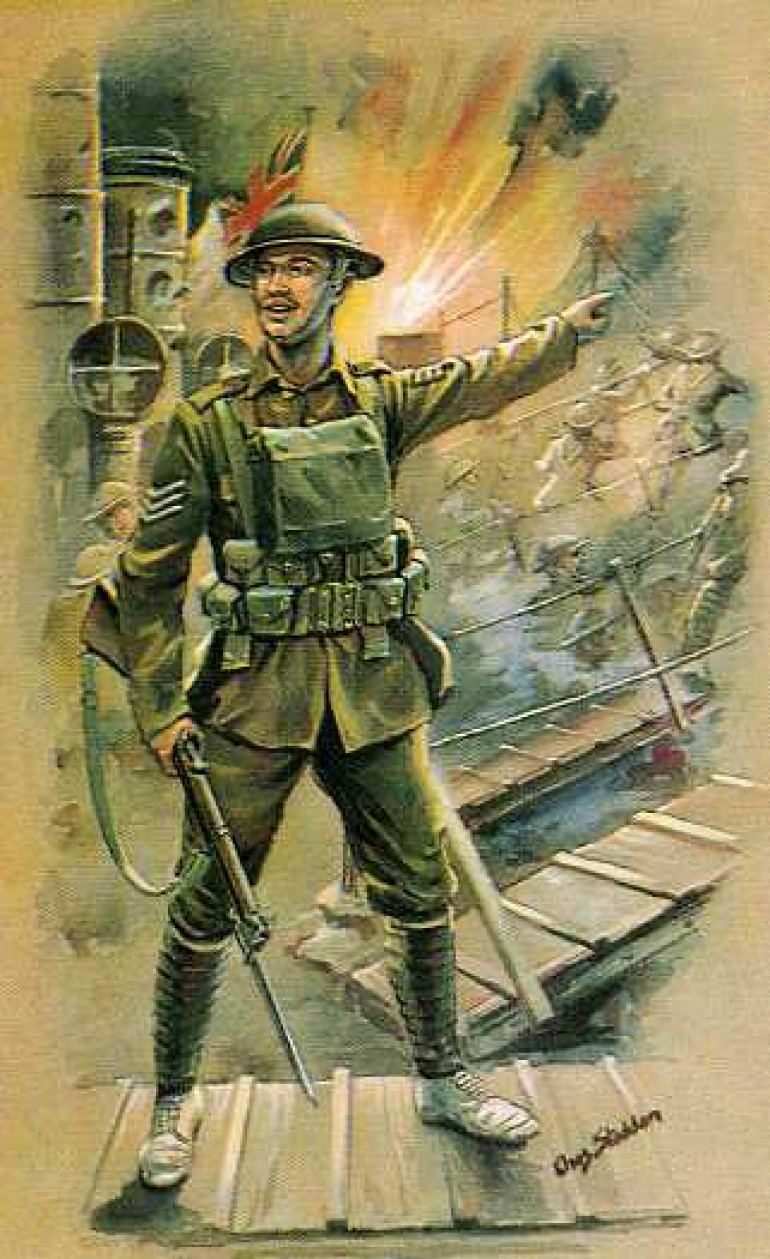 For example, this chap is wearing the exact same kit as the regular army at the time, but is marked as a Royal Marine by his various badges that, at most scales, are a little hard to make out.
For example, this chap is wearing the exact same kit as the regular army at the time, but is marked as a Royal Marine by his various badges that, at most scales, are a little hard to make out.In the aftermath of the war, the British Government looked to try to save money on it’s war spending and so in the the years following peace the Royal Marine Light Infantry and the Royal Marine Artillery were merged together with the Royal Marine Artillery losing their purpose and requiring the Corps to rely on Royal Artillery units for support (a system that sort of still stands today). While it’s not relevant to minis, this is why the Royal Marines have the dress uniform they do; they kept the blue of the artillery branch and kept the red for the Officer’s Mess.
As it going to be typical from here on out, Marines can usually be represented by the standard infantry with very few exceptions, though if you wished to represent the Naval Division at the onset of war you will have to look for some specific minis that may be hard to find.

































![Very Cool! Make Your Own Star Wars: Legion Imperial Agent & Officer | Review [7 Days Early Access]](https://images.beastsofwar.com/2025/12/Star-Wars-Imperial-Agent-_-Officer-coverimage-V3-225-127.jpg)


